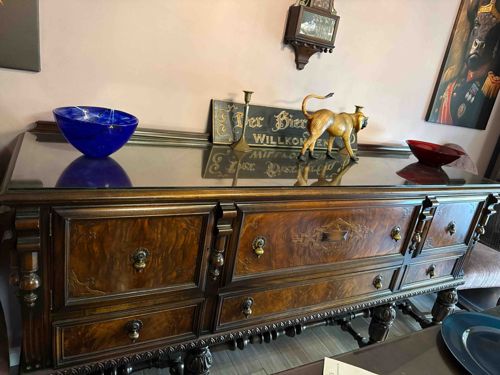
Victorian Era Sideboard or Buffet
This appears to be a substantial Victorian-era sideboard or buffet, likely crafted from a combination of solid wood and veneers, possibly walnut or a similar dark, rich hardwood given the intricate grain patterns. The dark brown color of the wood is consistent throughout, with a highly polished surface finish that displays some reflectivity. The top surface of the piece is covered with a dark, reflective material, possibly a custom-cut piece of glass or a highly lacquered surface, which protects the wood underneath and adds to its sheen. The sideboard features a complex architectural structure, characterized by multiple panels, drawers, and possibly cabinet doors. On the left side, a cabinet door with a deeply carved or applied ornamentation is visible, adorned with a decorative brass or bronze pull. To the right of that, there are two drawers, also fitted with matching ornate metal pulls. The central section appears to have two larger drawers, showcasing remarkable book-matched veneer patterns that create a symmetrical, swirling design, hinting at high-quality craftsmanship. The rightmost section also features two smaller drawers. The entire front facade is heavily embellished with intricate carvings, including reeded columns or pilasters separating the sections, and highly detailed corbels or brackets beneath the pilasters. The base of the sideboard is particularly ornate, featuring turned and carved legs, and a lower rail with a series of finely turned spindles or decorative elements, contributing to a robust and impressive appearance. The overall style suggests a late 19th-century origin, possibly in the Renaissance Revival or Aesthetic Movement, given the emphasis on rich textures, dark woods, and elaborate detailing. There are no overt signs of significant damage visible, but the reflective surface makes it difficult to assess minor wear or patina on the wood finish directly. The metal hardware shows a natural patina consistent with age. No specific maker's marks are discernible from the image.
AI-Generated Appraisal Disclaimer
Estimated Value
$1,800 - $2,800
Basic Information
Category
Furniture
Appraised On
December 20, 2025
Estimated Value
$1,800 - $2,800
Additional Details Provided By Owner
User Provided Information
Kittenger
Item Description
This appears to be a substantial Victorian-era sideboard or buffet, likely crafted from a combination of solid wood and veneers, possibly walnut or a similar dark, rich hardwood given the intricate grain patterns. The dark brown color of the wood is consistent throughout, with a highly polished surface finish that displays some reflectivity. The top surface of the piece is covered with a dark, reflective material, possibly a custom-cut piece of glass or a highly lacquered surface, which protects the wood underneath and adds to its sheen. The sideboard features a complex architectural structure, characterized by multiple panels, drawers, and possibly cabinet doors. On the left side, a cabinet door with a deeply carved or applied ornamentation is visible, adorned with a decorative brass or bronze pull. To the right of that, there are two drawers, also fitted with matching ornate metal pulls. The central section appears to have two larger drawers, showcasing remarkable book-matched veneer patterns that create a symmetrical, swirling design, hinting at high-quality craftsmanship. The rightmost section also features two smaller drawers. The entire front facade is heavily embellished with intricate carvings, including reeded columns or pilasters separating the sections, and highly detailed corbels or brackets beneath the pilasters. The base of the sideboard is particularly ornate, featuring turned and carved legs, and a lower rail with a series of finely turned spindles or decorative elements, contributing to a robust and impressive appearance. The overall style suggests a late 19th-century origin, possibly in the Renaissance Revival or Aesthetic Movement, given the emphasis on rich textures, dark woods, and elaborate detailing. There are no overt signs of significant damage visible, but the reflective surface makes it difficult to assess minor wear or patina on the wood finish directly. The metal hardware shows a natural patina consistent with age. No specific maker's marks are discernible from the image.
Get Your Items Appraised
Instant estimates of your treasures with AI-powered instant appraisals